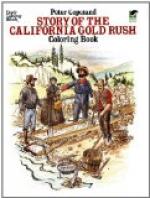Humming-birds, or “hummers,” as the boys call them, are plenty in city and country and so fearless that they will take a bath in the spray of the garden-hose, or dart their long bills in the fuchsias almost within your reach. The bill shields a double tongue, which gets not only honey, but small insects from the flower or off the leaves. The humming-bird’s tiny nest is a soft, round basket, not much bigger than half a walnut-shell, and holding two eggs, which are like small-white beans. Bits of moss and gray cobwebs are woven in this nest till it looks like the branch itself; and here the little mother in her plain brown dress hatches out and feeds the baby “hummers.” Her husband has glistening ruby feathers at his throat and green spots on his head and back that glow in the sun like jewels.
The highest class of birds is the “perchers,” and many friends of yours belong to this. There are two families, however, of perchers, those that call and the song-birds. Calling over and over their peculiar note, the pewees, flycatchers, and king-birds, fly through the forests. The crow and blue jay belong to the singers, you will be surprised to hear. And what a crowd of these song-birds there are trilling and warbling in the sunshine! Have you ever watched the meadow-lark singing as he sits on guard on the fence, while the rest of his brown-coated yellow-vested flock run along the field picking up seeds and insects?
Then there are the linnets, or “redheads,” who sing their sweet, merry tunes all summer, and if they do take a cherry or two the farmer should not grumble. They destroy many bugs and caterpillars and eat weed-seeds that might trouble the fruit-grower more than the missing cherries. The yellow warbler, sometimes called the wild canary, flits through bush and tree and trills its gay notes in town and country. Song-sparrows, thrushes, and bluebirds warble far and near, while the red-winged blackbird makes music in wet, swampy places. The robin, who comes to city gardens in the winter, has a summer home in the mountains or redwoods. There, too, the saucy jay screams and chatters, and flashes his blue wings as he flies, scolding all the time.
In Southern California, among the orange groves or in gardens, the mocking-bird trills in sweet, liquid notes his wonderful song. He mimics, too, many sounds he hears, and sometimes when caged will whistle tunes or say words. The mocker can crow or cackle like the chickens, or mew like the cat. Then he will whistle clear and loud till dogs or boys answer his call. When they find themselves fooled, it is said, he mimics a laugh.
From April to July the birds are busy, nesting, feeding their families, or teaching them to fly. Many eggs never hatch, and some are destroyed by wild animals. Boys often rob a whole nest to have one little blown egg in their collections. Then again the mother is killed and her brood starves to death. When the parent birds are teaching the nestlings to fly, cats also catch the little ones. So you see the poor feathered things have many enemies.




